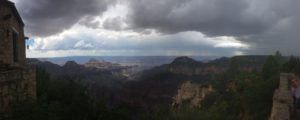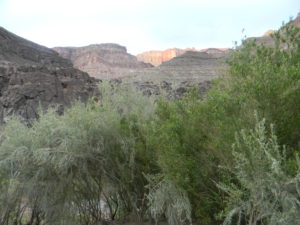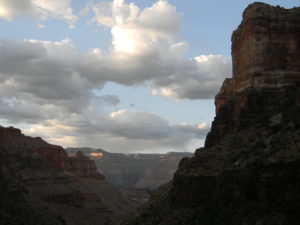Where Does the Grand Canyon Begin and End?
Grand Canyon has a beginning, middle, and end just like any wonderful story. It unfolds with beautiful poetry like the most epic novels, films, and greatest stories ever told. It unfolds using astounding special effects, and comes to a close fit for the Oscar’s. Lyrical hyperbole aside, Grand Canyon does, in fact, begin and end in a very official way.
First, we need to pick which beginning and ending we are choosing. Do we choose time? Space? Map definition? Secondly, we must define where the beginning and end are for each of these definitions. Finally, we can choose which beginning and ending we like best!
Follow The Goat as he takes the road less traveled through time and space on the Colorado River.

The Colorado River
To truly speak to the beginning and end of the Grand Canyon, one must first speak of the river that is responsible for its existence. The mighty Colorado River, with its headwaters in Rocky Mountain National Park, is the primary waterway of the American Southwest. It drains massive mountain ranges from Colorado, Utah, California, and Nevada. The Rocky Moutains, the Uintahs and Henry Mountain in Utah, and the Great Basin Range shed their waters into the Colorado River.
Geologist debate about the exact history of the river, but the most accepted theory is that it integrated roughly 6 million years ago. Before that, the Colorado had existed as two separate entities. In the north, lakes and such collected in basins that drained the Rockies and Uintas. In the south the river system drained the Great Basin and Gila Mountains, outletting into the Pacific Ocean. Action along the San Andreas Fault opened the Gulf of California which captured the lower drainage. The upper and lower rivers eventually were connected though various mechanisms like headward erosion, stream piracy, and springs integration (see our blog How Was Grand Canyon Formed?).
Today it courses 1,500 miles through the mountains and deserts to the Sea of Cortez in the Gulf of California. The banks of the Colorado are home to four National Parks and five National Monuments.
Don’t be fooled….
The Colorado River roils at 20,000 cubic feet per second, so its calm appearance is deceiving. Some of the most challenging whitewater in the American Southwest are found in the canyon depths. Two class 5 and ten class 4 rapids exist in Grand Canyon, along with nearly twenty class 3 and 2 rapid sections. A journey by boat though Grand Canyon is both exhilarating and death-defying. Above the river, the Tonto Trail winds 99 miles through nearly a third of Grand Canyon, providing a unique bird’s eye perspective of the Colorado River and a fabulous Inner Gorge experience.
National Parks: Rocky Mountain, Arches, Canyonlands, Grand Canyon
National Monuments: Colorado, Bears Ears, Grand Staircase-Escalante, Grand Canyon-Parashant

The Grand Canyon
The most stunning feature of the Colorado River is its Grand Canyon. Grand Canyon was named by Major John Wesley Powell, head of the United States Geological Survey. Powell was the first known person to successfully navigate the Colorado River through Grand Canyon by boat. He named several features along the Colorado River including Glen Canyon, Grand Canyon, The Gates of Lodore, and Flaming Gorge.
During his journey Powell documented the several rock layers present in the Canyon. These layers are the subject of our first option for Grand Canyon’s Beginning and End.
Time
Grand Canyon “began” 1.9 billion years ago as the North American continent was sutured together by drifting tectonic plates. This collision created a great seaside mountain range, and laid the foundation for everything. After that, hundreds of millions of years of sedimentation cycles occurred. Various oceans, rivers, and deserts covered the landscape and set the stage for deep dissection.
Similarly, Grand Canyon “began” six million years ago. Deep below the surface, faults slipped and created the East Kaibab Monocline. This wrinkle in the Earth’s crust altered the landscape, and forced a river to cut around and through it. The river was the Colorado, and its gash is known as the Grand Canyon.
Where does it end? I don’t know, but I can tell you what I think. The Earth is a dynamic system, always in motion. Major tectonic action exists in all directions. To the south, the crust is pulling down and away. To the west the North American and Pacific plates struggle for position. The southeast is the home of the Rio Grande Rift, and place where the North American continent is opening toward the Gulf of Mexico. The Colorado River carves it daily from the inside out.
Although it will take many millions of years, the actions of these various movements will affect Grand Canyon. The river will carve away the remaining sediment and level itself with the oceans. The uplifted Colorado Plateau will fall back down to sea level, and Grand Canyon will be inundated by the very environments that created it.
Space
Grand Canyon officially begins, in map terms, at Lee’s Ferry in northern Arizona, 50 miles south of the Arizona/Utah border. The Paria river runs into the Colorado, and just below this confluence is Marble Canyon. Glen Canyon dam looms just upstream.

Lee’s Ferry, Marble Canyon, and Glen Canyon Dam
John D. Lee, pioneer of Lee’s Ferry, was an interesting man. He was a different person depending on your perspective. On one side he was a devout member of the LDS and a Mormon pioneer. On the other side he was an outlaw and murderer, accused of participating in the Mountain Meadows Massacre. The massacre killed nearly 120 travelers in a wagon train as part of the “Utah War”. The war was the height of tension between the US Government and the Mormon settlers in Utah.
His status as a fugitive of the US Government led Brigham Young to hide him away, sending him to the remote southern reaches of the Mormon Homeland. His mission was to create a crossing Colorado River to aid in the travel of Mormon settlers. The river is contained by sheer canyon walls for most of its course, except here. Just below Glen Canyon, just above Marble Canyon the walls drop and the river can be accessed from both sides.
John Lee built Lee’s Ferry, and furnished Lonely Dell Ranch. The project was complete 1873. Travelers used Lee’s Ferry to cross the Colorado River. Lee’s Ferry operated for nearly 60 years, until a bridge was built to accommodate the automobile.
Glen Canyon Dam
An abomination was created in 1963. Glen Canyon Dam, also known as Boulder Dam, has been one of the greatest travesties in engineering and land management history. Although you may enjoy Lake Powell, please remember why it is there in the first place. Read more on History of Glen Canyon.
Pearce Ferry and Hoover Dam
The human imprint upon Grand Canyon is apparent at its end. Hoover Dam stands sentinel over Pearce Ferry and the Grand Wash Cliffs just east of Las Vegas, Nevada. Hoover Dam was completed in 1933, and is an engineering marvel that put thousands of people to work during the Great Depression. It provides electricity to the city of Las Vegas and contains myriad recreation opportunities in Lake Mead. However, the official end to Grand Canyon is not the Hoover Dam, but rather Pearce Ferry.
The dramatic cliffs of Grand Canyon appear to plunge right into the river, signaling the end to the Grand Canyon and its National Park at river mile 277. Pearce Ferry was founded much the same as Lee’s Ferry, by Mormon pioneers looking for suitable river crossings.

Going Guided
Hiking and exploring Grand Canyon, or any of the National Parks, is a special experience. Although it is possible to see these places yourself, hiring a guide is a great idea. For instance, guiding services provide logistical support, and plan everything for your best possible trip. They provide a great safety net on the trail, and are trained in backcountry medicine. Above all, they provide a depth of knowledge of the region that turns a walk into a true adventure.
Blue Marble Adventure GeoTourism provides all of the support you need, and pairs that with expert geologist/guides. Our backcountry meals use fresh ingredients, and are planned by a professional chef. Furthermore, we provide top-of-the-line gear and passion for the places we explore. In conclusion, you can visit National Parks, but going with a guide can create and even more memorable experience. Don’t be shy, and call us!
The Goat’s Final Word
Your perspective determines where Grand Canyon begins or ends. Do you want time? Or do you want space? Grand Canyon officially begins at Lee’s Ferry near Marble Canyon, and ends at Pearce Ferry (now Hoover Dam). That’s the answer you were looking for! Or was it? Yes it was. In addition to the specific answer, we were also able to explore the more philosophical answers. Fun! Now, your task is to explore Grand Canyon from its beginning to its end, both in space and time.
Read our Blog!
Visit us for hiking adventures in a geologic time machine to Grand Canyon, Utah Canyon Country, and Arizona Red Rocks!
